

The Legend Of The Well To Hell: Unveiling The Myths And Facts
The tale of the "Well to Hell" has captivated imaginations and stirred debates for decades. It tells the story of scientists who allegedly drilled a hole deep into the Earth, only to discover a passageway to Hell, complete with the anguished screams of the damned. This legend, often recounted in religious circles, serves as a startling reminder of the power of storytelling in shaping beliefs and perceptions about the unknown. But is there any truth behind this chilling narrative?
What You Will Learn
- The origins of the "Well to Hell" legend and its appeal to religious groups.
- The actual scientific drilling conducted in Siberia and its findings.
- How and why the myth of the "Well to Hell" became widespread.
- The impact of storytelling on public perception of science and religion.
In the late 20th century, a story emerged that scientists in Siberia had drilled a hole reaching depths of 14.4 kilometers (approximately 9 miles). Allegedly, the drill bit began to spin uncontrollably, leading to claims that the center of the Earth was hollow. The myth continued with reports of temperatures exceeding 2,000 degrees and the horrifying sounds of suffering souls echoing from the depths. Such vivid tales ignited curiosity and fear, prompting many to believe in the existence of Hell beneath our feet.
However, scientific evidence suggests otherwise. In reality, the infamous Kola Superdeep Borehole project, which took place in the Kola Peninsula, only reached a depth of 12 kilometers. Here, scientists found unexpected geological formations, gas flows, and temperatures of around 180 degrees Celsius—far from the fiery inferno depicted in the legend. This scientific endeavor, instead of uncovering the gates of Hell, provided valuable insights into Earth's geology, showcasing the wonders and mysteries of our planet without resorting to supernatural explanations.

The transformation of the Kola project into the myth of the "Well to Hell" can be traced through media stories and personal anecdotes. In 1989, a sensational report aired on Trinity Broadcasting Network, claiming a miraculous discovery of Hell in Siberia. This narrative traveled far and wide, evolving as it passed through various channels, each embellishing the tale further. By the early 1990s, the story had morphed into a mainstream urban legend, complete with variations and adaptations that captured the imaginations of many.
Ultimately, the "Well to Hell" serves as a fascinating example of how urban legends can arise from genuine scientific endeavors. It highlights our tendency to lean towards dramatic narratives that resonate with our fears and beliefs. The embellishments surrounding this story not only showcase the power of storytelling but also challenge us to discern fact from fiction in our quest for knowledge.
Kamala Harris And The Misstatement About COVID-19 Deaths: A Fact-Check
The Truth Behind The Term "Hangover": Origins And Misconceptions
Understanding Weather Forecast Percentages: What They Really Mean

![[हिन्दी] The Urban Legend Of Well To Hell In Hindi The Well To Hell](https://i.ytimg.com/vi/zT5qhr4srho/maxresdefault.jpg)

